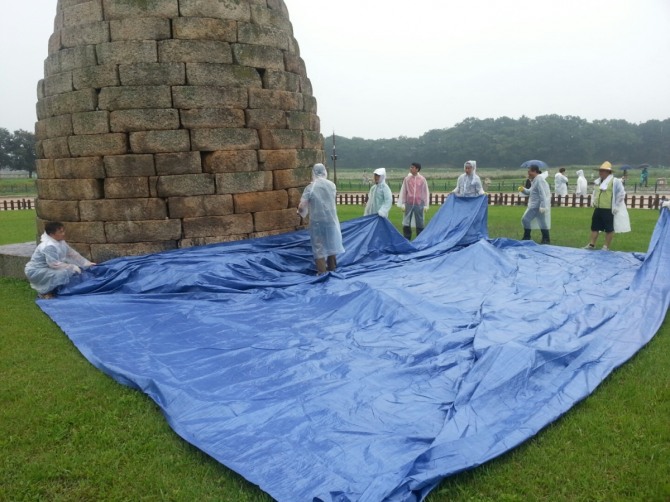Artifacts damaged in record-breaking earthquake in Gyeongju
Damage greater than initially thought
Numerous historical sites in Gyeongju suffered damage ranging from severe to minor cracks during the earthquake that hit the city last Monday, the largest to be recorded on the Korean Peninsula.
The Cultural Heritage Administration, which is in charge of preserving the country’s cultural sites, announced Sunday that some 60 cultural assets have been damaged. The ancient city of Gyeongju, the capital of Silla Kingdom (57 B.C. to 935), located north of Busan on the southeastern coast of the peninsula, houses the country’s main trove of Silla artifacts and is home to 31 National Treasures.
 |
| This Sept. 13 photo shows the Dabotap Pagoda (National Treasure No. 20) banister that was dislocated during the 5.8 magnitude earthquake that struck the historical city of Gyeongju, North Gyeongsang Province, Sept. 12. (Yonhap) |
Cheomseongdae Observatory, National Treasure No. 31, constructed in the early seventh century and Asia’s oldest extant astronomical observatory, was found leaning approximately 2 centimeters farther northward, while the gap at the southeastern corner of its hash-shaped upper stone has widened by an additional 5 centimeters, the Cultural Heritage Administration said in its latest statement. The tower was reported in 2014 to be leaning 20.5 centimeters northward from its original position due to the ground sinking.
A banister has been dislocated from the three-story Dabotap Pagoda, National Treasure No. 20 built in the eighth century. The three-story pagoda, standing 10.4 meters tall, is one of the most famous features of Gyeongju’s Bulguksa Temple, designated a World Cultural Asset by UNESCO in 1995. The banister, broken during the time of Japanese occupation, had been previously put together.
The granite stone temple Seokguram Grotto from the eighth century, National Treasure No. 24 and designated a World Cultural Heritage Site by UNESCO in 1995, was found to have been unharmed.
Cracks have been discovered on a number of other historical sites -- mainly on roof tiles and walls ?- which the Cultural Heritage Administration’s Risk Management Division said are “not serious taking into consideration the magnitude of the earthquake.”
The earthquake that hit Gyeongju last Monday evening at 8:32 p.m. measured 5.8 on the Richter scale, the largest one to be witnessed in the country since the Korea Meteorological Administration began monitoring seismic activities in 1978. The main earthquake was preceded by a 5.1-magnitude earthquake less than an hour earlier.
As of Sunday morning, some 352 aftershocks -- 15 of them stronger than a magnitude of 3.0 -- have been detected, the Korea Meteorological Administration said.
Typhoon worries
 |
| Officials from the North Gyeongsang Province government place a rainproof cover at the foot of Cheomseongdae Observatory (National Treasure No. 31) in Gyeongju, Friday, in preparation for the approaching Typhoon Malakas, which was expected to dump heavy rain in the area. (Yonhap) |
Meanwhile, the city is attempting to prevent further damage by installing rainproof tents over some 45 historical sites, the official said. The tents are meant to cover cracks in stone structures to prevent rainwater from seeping in and softening their foundations.
Typhoon Malakas originated west of Guam last Tuesday and was reported to be near Taiwan’s Taipei area as of Sunday morning. Korea’s southern regions are expecting heavy rains in the coming days with the state weather agency forecasting up to 150 millimeters of rain in the Gyeongju area along with strong winds and high tides of up to 6 meters off the southern coast.
By Rumy Doo (doo@heraldcorp.com)




























